Home
Gallienus
Publius Licinius Egnatius Gallienus was the son of Valerian and Egnatia Marinianae. Around august/september 253 his father had made him co-ruler. After his fathers capture by the Persian king Shapur I in the year 260 he became sole ruler. Gallienus with certainty had two sons, Valerian the younger and Saloninus, but there was probably a third son named Marinianus. Nothing is known about this boy except that he was consul in 268. Gallienus oldest son Valerian was made Caesar during the second half of the year 256 but died in 258 under mysterieus circumstances, probably in the vicinity of Viminacium. His death had probably something to do with the revolt of Ingenuus, the governor of Pannonia Inferior. This could explain why the revolt was put down with much bloodshed en resulted probably in the closing of the mint at Viminacium. 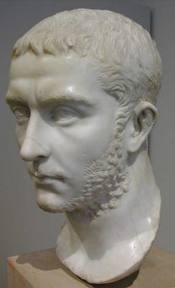 After the death of his oldest son his youngest son Saloninus was proclaimed Caesar in 258. While fighting in the Balkan aerea Gallienus left his son Saloninus behind at Colonia Agrippina (Cologne) under the care of a man named Silvanus. During his stay in the Balkan aerea the Semnoni and the Juthungi invaded northern Italy. Gallienus managed to stop them near Milan after which they tried to return to the unoccupied part of Germania trough the province of Raetia. At Augusta Vindelicum (Augsburg) their path was cut off by an army under the command of Postumus and one M. Simplicinius Genialis. In a battle that took place on the 24 and 25 of april 260 they were defeated. Under the reign of Postumus an altar was erected remembering the event that took place there. After the victory over the Germans Postumus must have retreated in the direction of Gaul but came in to conflict with Gallienus son Saloninus and Silvanus. The reason for this conflicht seems to have been the spoils of war Postumus gained after defeating the Germans. Postumus, a general or probably governor of Germania Inferior, managed to gain the loyalty of his legions in this conflict and they proclaimed him emperor, probably in Bonna (Bonn). What could have helped Postumus in this conflict was that maybe the news of the defeat of Valerian against the Persians in the east was starting to spread. Also in the Balkan aerea there was a new revolt under the leadership of Regalian, the governor of Pannonia Superior. After the bloody suppresion of the revolt of Ingenuus they started a new one. This revolt was suppresed in 260 or ended in the murder of Regalian by his own soldiers. In the mean time in the east, after the capture of Valerian by the Persians, Macrianus the Younger and Quietus were proclamed emperor around september 260. Macrianus the younger together with his father Macrianus Senior assembled an army and marched to the west to confront Gallienus. In the confusion Postumus took advantage of the situation to besiege the city of Cologne. In a last effort to turn the tide the young Saloninus was made Augustus but is was all too late. The city fell and Saloninus was murdered together with his protector Silvanus after which Germany, Gaul, Britain, and Spain fell into the hands of Postumus. Apparently it was the emperor Valarian who had gained the most respect and now with him out of the way everybody tried to tumble the reign of Gallienus. In the east both sons of the general Macrianus, Quietus and Macrianus the younger were proclaimed emperor by the legions in the east with Antioch as the centre of the uprising. Syria, Egypt and Asia Minor supported the revolt but on their way to Rome Macrianus Senior en Junior were defeated in the Balkans by Aureolus and Domitian, both generals loyal to Gallienus. The younger son Quietus was left behind in control of the east but was defeated by Odenathus, prince of Palmyra. Odenathus for the time being was tolerated by Gallienus as the strong man in the east with command over the legions. After the murder of Odenathus in a family dispute somewhere after august 267, his widow Zenobia took the power in the name of her young son Vabalathus. The Palmyran empire would last until the reign of Aurelian. After the defeat of the Macriani the governor of Egypt, Mussius Aemilianus who supported the revolt of the Macriani, tried to grasp the power but was soon executed. In 268 Gallienus had to stop a massive invasion of the Goths who invaded the Balkan aerea en threatened Thrace and Macedonia. In a massive battle they were defeated by Gallienus who for sure earnes a place next to Claudius Gothicus as savior of the empire. Shortly after these events Gallienus was betrayed by his general of the cavalry, Aureolus. After a skirmish near Pontirolo he retreated into the fortified city of Milan, the center of the cavalry. He declared himself loyal to the usurper Postumus, emperor of the Gallic empire and even struck coins in Postumus name in the mint of Milan. Gallienus started a siege of the city during which he was assassinated in a plot of his own generals. Also his wife Salonina and probably a young sone by the name of Marinianus were killed in the plot. His succesor was the popular general Claudius. The shift in power did not mean a liberation for the besieged Aureolus. He was killed after his surrender to Claudius. It is not clear if he was killed by rebellious soldiers or at the instigation of Claudius and the other generals.
After the death of his oldest son his youngest son Saloninus was proclaimed Caesar in 258. While fighting in the Balkan aerea Gallienus left his son Saloninus behind at Colonia Agrippina (Cologne) under the care of a man named Silvanus. During his stay in the Balkan aerea the Semnoni and the Juthungi invaded northern Italy. Gallienus managed to stop them near Milan after which they tried to return to the unoccupied part of Germania trough the province of Raetia. At Augusta Vindelicum (Augsburg) their path was cut off by an army under the command of Postumus and one M. Simplicinius Genialis. In a battle that took place on the 24 and 25 of april 260 they were defeated. Under the reign of Postumus an altar was erected remembering the event that took place there. After the victory over the Germans Postumus must have retreated in the direction of Gaul but came in to conflict with Gallienus son Saloninus and Silvanus. The reason for this conflicht seems to have been the spoils of war Postumus gained after defeating the Germans. Postumus, a general or probably governor of Germania Inferior, managed to gain the loyalty of his legions in this conflict and they proclaimed him emperor, probably in Bonna (Bonn). What could have helped Postumus in this conflict was that maybe the news of the defeat of Valerian against the Persians in the east was starting to spread. Also in the Balkan aerea there was a new revolt under the leadership of Regalian, the governor of Pannonia Superior. After the bloody suppresion of the revolt of Ingenuus they started a new one. This revolt was suppresed in 260 or ended in the murder of Regalian by his own soldiers. In the mean time in the east, after the capture of Valerian by the Persians, Macrianus the Younger and Quietus were proclamed emperor around september 260. Macrianus the younger together with his father Macrianus Senior assembled an army and marched to the west to confront Gallienus. In the confusion Postumus took advantage of the situation to besiege the city of Cologne. In a last effort to turn the tide the young Saloninus was made Augustus but is was all too late. The city fell and Saloninus was murdered together with his protector Silvanus after which Germany, Gaul, Britain, and Spain fell into the hands of Postumus. Apparently it was the emperor Valarian who had gained the most respect and now with him out of the way everybody tried to tumble the reign of Gallienus. In the east both sons of the general Macrianus, Quietus and Macrianus the younger were proclaimed emperor by the legions in the east with Antioch as the centre of the uprising. Syria, Egypt and Asia Minor supported the revolt but on their way to Rome Macrianus Senior en Junior were defeated in the Balkans by Aureolus and Domitian, both generals loyal to Gallienus. The younger son Quietus was left behind in control of the east but was defeated by Odenathus, prince of Palmyra. Odenathus for the time being was tolerated by Gallienus as the strong man in the east with command over the legions. After the murder of Odenathus in a family dispute somewhere after august 267, his widow Zenobia took the power in the name of her young son Vabalathus. The Palmyran empire would last until the reign of Aurelian. After the defeat of the Macriani the governor of Egypt, Mussius Aemilianus who supported the revolt of the Macriani, tried to grasp the power but was soon executed. In 268 Gallienus had to stop a massive invasion of the Goths who invaded the Balkan aerea en threatened Thrace and Macedonia. In a massive battle they were defeated by Gallienus who for sure earnes a place next to Claudius Gothicus as savior of the empire. Shortly after these events Gallienus was betrayed by his general of the cavalry, Aureolus. After a skirmish near Pontirolo he retreated into the fortified city of Milan, the center of the cavalry. He declared himself loyal to the usurper Postumus, emperor of the Gallic empire and even struck coins in Postumus name in the mint of Milan. Gallienus started a siege of the city during which he was assassinated in a plot of his own generals. Also his wife Salonina and probably a young sone by the name of Marinianus were killed in the plot. His succesor was the popular general Claudius. The shift in power did not mean a liberation for the besieged Aureolus. He was killed after his surrender to Claudius. It is not clear if he was killed by rebellious soldiers or at the instigation of Claudius and the other generals.
The coins of Gallienus from Viminacium
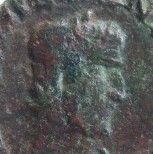 |
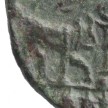 |
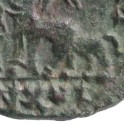 |
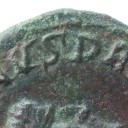 |
Denominations struck: sestertius
The sestertii have a portrait with laurel wreath.
Used notations of the local year:
AN XVI, used from july 254 until july 255.
Obverse text variations used:
A:
IMP GALLIENVS P AVG
B: IMP GALLIENVS AVG
Reverse text variations used:
a:
PMSC - OLVIM
b: PMSCOLVIM
c: PMSO - CLVIM
AN XVI |
|
| Sestertius ANNO XVI - 254/255 - Pick 192 - Martin 7.13.1 - Varbanov 241 | |
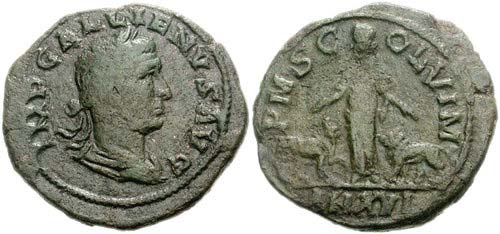 |
Classical Numismatic Group Weight: 10,28 grams Diameter: 28 mm |
Obverse: Bust of Gallienus to the right with laurel wreath, part of paludamentum (cloak, cape) visible on the shoulder. Text: (B:) IMP GALLIENVS AVG (IMPERATOR GALLIENVS AVGVSTVS) - Emperor Gallienus Augustus. Reverse: Woman (Moesia) standing with head to the left holding her right hand over a bull and het left hand over a lion. Text: (a:) PMSC - OLVIM (PROVINCIA MOESIA SVPERIOR COLONIA VIMINACIVM) - Province Moesia Superior Colony Viminacium. Exergue: AN XVI (ANNO XVI) - year 16 (254/255). |
|
| Sestertius ANNO XVI - 254/255 - Pick 193 - Martin 7.14.1 - Varbanov 242 | |
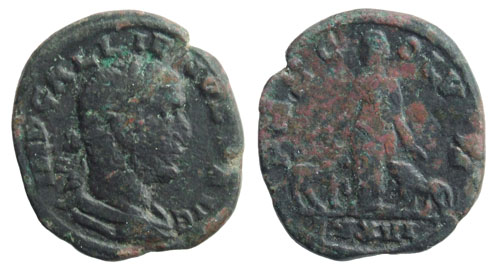 |
Private collection Weight: 12,09 grams Diameter: 28,0 mm |
Obverse: Bust of Gallienus to the right with laurel wreath, part of paludamentum (cloak, cape) visible on the shoulder. Text: (A:) IMP GALLIENVS P AVG (IMPERATOR GALLIENVS PIVS AVGVSTVS) - Emperor Gallienus, dutiful Augustus. Reverse: Woman (Moesia) standing with head to the left holding her right hand over a bull and het left hand over a lion. Text: (a:) PMSC - OLVIM (PROVINCIA MOESIA SVPERIOR COLONIA VIMINACIVM) - Province Moesia Superior Colony Viminacium. Exergue: AN XVI (ANNO XVI) - year 16 (254/255). |
|
| Sestertius ANNO XVI - 254/255 - Pick - - Martin 7.14 var. - Varbanov - | |
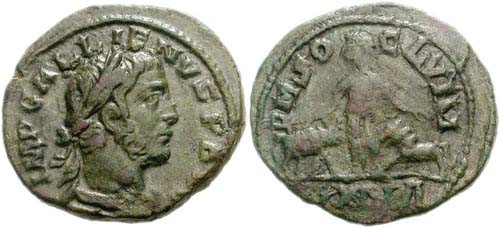 |
Classical Numismatic Group Weight: 11,98 grams Diameter: 28 mm |
Obverse: Bust of Gallienus to the right with laurel wreath, part of paludamentum (cloak, cape) visible on the shoulder. Text: (A:) IMP GALLIENVS P AVG (IMPERATOR GALLIENVS PIVS AVGVSTVS) - Emperor Gallienus, dutiful Augustus. Reverse: Woman (Moesia) standing with head to the left holding her right hand over a bull and het left hand over a lion. Text: (c:) PMSO - CLVIM (PROVINCIA MOESIA SVPERIOR COLONIA VIMINACIVM) - Province Moesia Superior Colony Viminacium. Exergue: AN XVI (ANNO XVI) - year 16 (254/255). Remark: The reverse legend has the die makers mistake OCL in stead of COL. |
|
| Sestertius ANNO XVI - 254/255 - Pick 194 - Martin 7.15.1 - Varbanov 239 | |
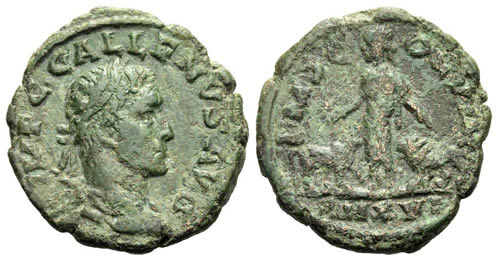 |
Photo: Courtesy of Numismatik Lanz Weight: 10,35 grams Diameter: 26 mm |
Obverse: Bust of Gallienus to the right with laurel wreath, part of paludamentum (cloak, cape) visible on the shoulder. Text: (C:) IMP C GALLENVS AVG (IMPERATOR CAESAR GALLIENVS AVGVSTVS) - Emperor, Caesar Gallienus Augustus. Reverse: Woman (Moesia) standing with head to the left holding her right hand over a bull and het left hand over a lion. Text: (a:) PMSC - OLVIM (PROVINCIA MOESIA SVPERIOR COLONIA VIMINACIVM) - Province Moesia Superior Colony Viminacium. Exergue: AN XVI (ANNO XVI) - year 16 (254/255). Remark: On this coin the name of Gallienus is written as GALLENVS without a letter i. Another remarkable thing on this coin is the powerfull portrait of Gallienus. |
|
| Sestertius ANNO XVI - 254/255 - Pick 193 - Martin 7.14.1 - Varbanov 242 | |
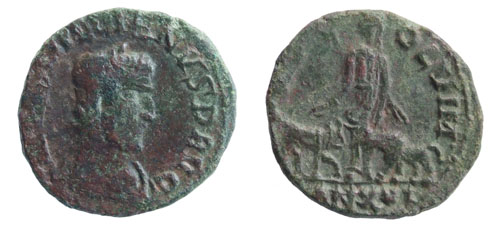 |
Private collection Weight: 10,49 grams Diameter: 26,21 mm |
| Obverse: Bust of Gallienus to the right with laurel wreath, part of paludamentum (cloak, cape) visible on the shoulder. Text: (A:) IMP GALLIENVS P AVG (IMPERATOR GALLIENVS PIVS AVGVSTVS) - Emperor Gallienus, dutiful Augustus. Reverse: Woman (Moesia) standing with head to the left holding her right hand over a bull and het left hand over a lion. Text: (a:) PMSC - OLVIM (PROVINCIA MOESIA SVPERIOR COLONIA VIMINACIVM) - Province Moesia Superior Colony Viminacium. Exergue: AN XVI (ANNO XVI) - year 16 (254/255). Remark: Next to wel made sestertii like the previous 3 specimens there also exist very crude ones. Usualy the sestertii in the name of Valerian and Gallienus are of poor quality with simple portraits like the next 3 specimens. |
|
| Sestertius ANNO XVI - 254/255 - Pick 193 - Martin 7.14.1 - Varbanov 242 | |
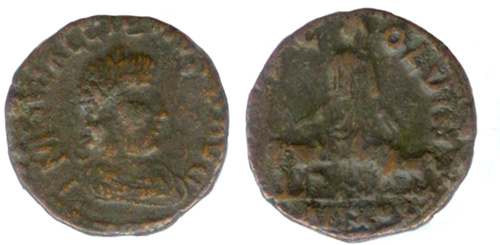 |
Collection Scott Sexton on
Tantalus coin registry Weight: 9,88 grams Diameter: 26 mm |
Obverse: Bust of Gallienus to the right with laurel wreath, part of paludamentum (cloak, cape) visible on the shoulder. Text: (A:) IMP GALLIENVS P AVG (IMPERATOR GALLIENVS PIVS AVGVSTVS) - Emperor Gallienus, dutiful Augustus. Reverse: Woman (Moesia) standing with head to the left holding her right hand over a bull and het left hand over a lion. Text: (a:) PMSC - OLVIM (PROVINCIA MOESIA SVPERIOR COLONIA VIMINACIVM) - Province Moesia Superior Colony Viminacium. Exergue: AN XVI (ANNO XVI) - year 16 (254/255). |
|
| Sestertius ANNO XVI - 254/255 - Pick 195 - Martin 7.14.1 - Varbanov 240 | |
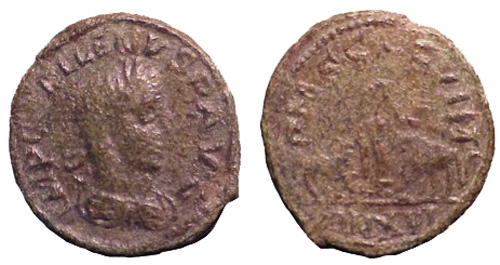 |
Collection scrumhalf on Tantalus coin registry Weight: 10,48 grams Diameter: 27 mm |
Obverse: Bust of Gallienus to the right with laurel wreath, part of paludamentum (cloak, cape) visible on the shoulder. Text: (B:) IMP C GALLIENVS P AVG (IMPERATOR CAESAR GALLIENVS PIVS AVGVSTVS) - Emperor, Caesar Gallienus, dutiful Augustus. Reverse: Woman (Moesia) standing with head to the left holding her right hand over a bull and het left hand over a lion. Text: (b:) PMSCOLVIM (PROVINCIA MOESIA SVPERIOR COLONIA VIMINACIVM) - Province Moesia Superior Colony Viminacium. Exergue: AN XVI (ANNO XVI) - year 16 (254/255) Remark: The head of Moesia does not interrupt the reverse text. |
|
| Sestertius ANNO XVI - 254/255 - Pick 195 var. - Martin 7.14.1 - Varbanov 240 | |
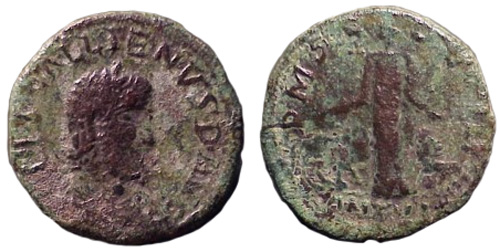 |
Collection scrumhalf on Tantalus coin registry Weight: 9,50 grams Diameter: 26 mm |
Obverse: Bust of Gallienus to the right with laurel wreath, part of paludamentum (cloak, cape) visible on the shoulder. Text: (B:) IMP C GALLIENVS P AVG (IMPERATOR CAESAR GALLIENVS PIVS AVGVSTVS) - Emperor, Caesar Gallienus, dutiful Augustus. Reverse: Woman (Moesia) standing with head to the left holding her right hand over a bull and het left hand over a lion. Text: (a:) PMSC - OLVIM (PROVINCIA MOESIA SVPERIOR COLONIA VIMINACIVM) - Province Moesia Superior Colony Viminacium. Exergue: AN XVI (ANNO XVI) - year 16 (254/255) Remark: Strange tall Moesia on the reverse, her head is interrupting the reverse text between the letters C and O. |
|